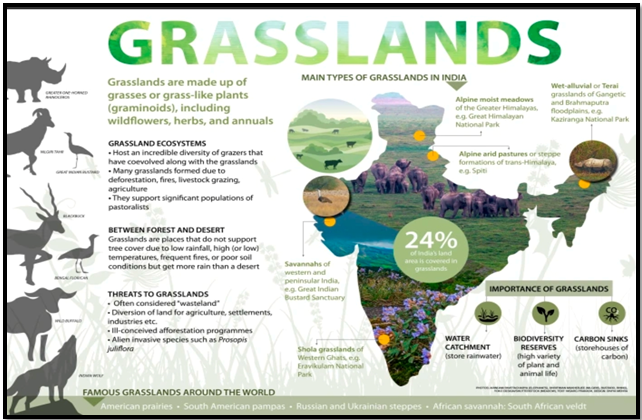RESTORATION OF BANNI GRASSLANDS IN KACHCHH, GUJARAT
Syllabus:
GS 3:
- Ecosystem and related challenges.
- Conservation, Environmental Pollution and Degradation, Environmental Impact Assessment.
Why in the News?
The Banni grasslands of Kachchh, Gujarat, one of India’s largest grassland ecosystems, are under focus due to a recent study assessing their suitability for sustainable restoration. The study highlights the critical need for conservation and offers a strategic approach to restoring degraded grasslands, crucial for biodiversity and climate resilience.
Source: RoundGlass
Overview and Findings of the Study:
- Significance of Grasslands: Grasslands, one of the largest ecosystems globally, offer essential services like carbon storage, climate mitigation, and pollination, supporting unique species and human well-being.
- Threats to Grasslands: Grasslands worldwide face degradation due to deforestation, overgrazing, agriculture, and urbanization, with 49% of global grasslands In India, grasslands cover 24% of the total land area, threatened by agricultural conversion and invasive species.
- Banni Grasslands: The Banni grasslands in Kachchh, Gujarat, once spanned 3,800 sq. km but have shrunk to 2,600 sq. km. A new study by researchers at KSKV Kachchh University assesses the suitability of different areas for sustainable restoration.
- Study Findings: The study categorized Banni into five zones: 36% “highly suitable,” 28% “suitable,” 27% “moderately suitable,” 7% “marginally suitable,” and 2% “not suitable” for restoration. The first two categories can be easily restored with adequate water sources.
- Restoration Strategies: The “moderately suitable” zone requires minimal intervention, while the “marginally suitable” and “not suitable” zones need terracing, fertilizers, and protection from erosion and salt intrusion for restoration.
About Banni Grassland
|
Study Findings and Analysis
- Suitability Assessment: Researchers classified Banni into five categories based on suitability for restoration: highly suitable (36%), suitable (28%), moderately suitable (27%), marginally suitable (7%), and not suitable (2%).
- Restoration Methods: The “highly suitable” and “suitable” zones can be restored with water sources. The “moderately suitable” zone needs minimal intervention, while the “marginally suitable” and “not suitable” zones require terracing, fertilizers, and erosion control.
- Holistic Assessment: Unlike previous studies focusing on sample plots or single vegetation indicators, this study offers a comprehensive analysis, including soil characteristics, nutrients, and satellite data.
- Importance of Soil Analysis: The study considered multiple soil characteristics, including nutrient availability, acidity, texture, salinity, and water-holding capacity, providing a complete picture of land suitability.
- Satellite Data Integration: Satellite data, including slope, land use, and geomorphology, were used to enhance the accuracy of the suitability analysis, making the study robust and reliable.
Methodology and Impact
- Comprehensive Methodology: The study involved soil sampling from 45 locations and geomorphological analysis, using satellite data from theS. Sentinel 2 and ASTER satellites to assess land suitability.
- Scientific Publication: The findings were published in the journal Scientific Reports in June, showcasing the rigorous research and its potential impact on grassland restoration efforts.
- Research Team: The study was led by Seema Bhargav Sharma, with contributions from Mahesh G. Thakkar, and research scientist Rupak Dey, highlighting a collaborative effort in environmental research.
- Policy Implications: The study provides a foundation for legal and regulatory frameworks to protect and rehabilitate degraded grasslands, potentially guiding policy decisions by the National Green Tribunal (NGT).
- Biodiversity and Livelihoods: The research aims to support biodiversity conservation and improve livelihoods for local communities dependent on grasslands, emphasizing sustainable management practices.
Challenges Faced by Grasslands in India
- Agricultural Conversion: Large areas of grasslands in India are being converted into agricultural land, leading to a significant loss of native grassland ecosystems. This change disrupts the habitat of many species and reduces biodiversity.
- Invasive Species: The spread of invasive plant species, such as Prosopis juliflora (Mesquite), has severely affected the natural composition and regeneration of grasslands, leading to further degradation of these ecosystems.
- Overgrazing: Unregulated grazing by livestock, especially in regions dependent on pastoralism, leads to overgrazing. This practice results in soil erosion, loss of vegetation cover, and reduced land productivity.
- Urbanization and Industrialization: Rapid urban expansion and industrial development encroach upon grassland areas, leading to habitat destruction, fragmentation, and pollution, which further endangers the fragile grassland ecosystems.
- Policy and Conservation Neglect: Grasslands often receive less attention compared to forests in conservation policies and government initiatives. This bias leads to inadequate protection and management of grasslands, exacerbating their degradation.
Expert Insights and Recommendations
- Climate Change Mitigation: Grasslands play a crucial role in climate change mitigation by sequestering carbon dioxide, making their restoration vital for environmental sustainability.
- Bird Habitat: Grasslands are critical breeding grounds for species like the great Indian bustard and Bengal florican, but shrinking areas due to human activities threaten biodiversity.
- Ecosystem Services: Restored grasslands provide valuable ecosystem services, including pollination, climate regulation, and habitat preservation, essential for maintaining ecological balance.
- Call to Action: Experts emphasize the importance of action plans to conserve and restore grasslands, ensuring their continued contribution to biodiversity and climate resilience.
- Future Directions: The study’s findings can inform future restoration projects and policies, guiding efforts to protect and rehabilitate grasslands in India and beyond, crucial for ecological and economic sustainability.
Conclusion
Restoring the Banni grasslands is essential for preserving biodiversity, supporting livelihoods, and combating climate change. The recent study provides a comprehensive framework for sustainable grassland management, emphasizing the importance of ecological restoration. A collaborative approach between policymakers, local communities, and conservationists is vital to ensure the long-term health of these ecosystems.
Source:The Hindu
Mains Practice Question
Discuss the challenges faced by grasslands in India and evaluate the importance of sustainable grassland restoration for ecological balance and climate resilience. Provide suggestions for effective grassland management.
Associated:
https://universalinstitutions.com/indias-open-ecosystem-facing-an-unusual-threat/




